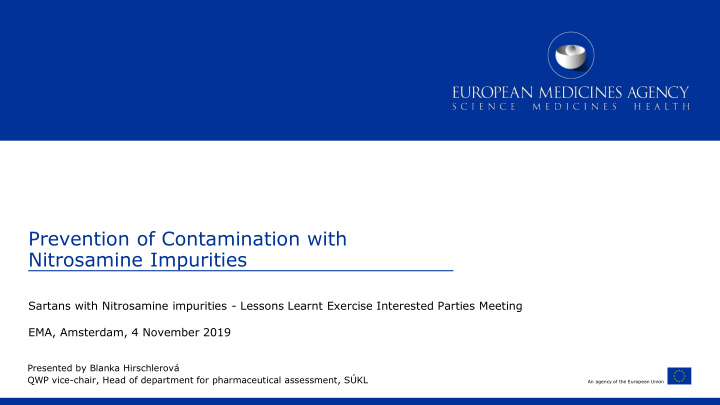



Prevention of Contamination with Nitrosamine Impurities Sartans with Nitrosamine impurities - Lessons Learnt Exercise Interested Parties Meeting EMA, Amsterdam, 4 November 2019 Presented by Blanka Hirschlerová QWP vice-chair, Head of department for pharmaceutical assessment, SÚKL An agency of the European Union
Overview of Presentation Current safeguards against mutagenic impurities • Applicable guidance • Root causes identified to date • Case histories • Gaps and weaknesses in current framework • 1
Applicable Guidance and Monographs Guideline name and scope Ph. Eur. 2034 (Substances for Pharmaceutical Use) – general legally • binding quality requirements, other guidance flows from here Guideline on the Chemistry of Active Substances – information to be • submitted in quality dossiers ICH Q11 – Developing manufacturing processes for APIs • ICH Q3A – Qualifying impurities in APIs • ICH M7 – Evaluation and control of mutagenic impurities • ICH Q7 – GMP for APIs • ICH Q9 – Quality risk management • ICH Q10 – Pharmaceutical quality system • 2
Chemistry of Active Substances “ Information on impurities and their carry-over should be provided. This includes related • substances, residual solvents, elemental impurities, reagents and those derived from reagents. The related substances considered as potential impurities arising from the synthesis and degradation products should be discussed and described briefly including an indication of their origin. The mutagenic potential of impurities should be addressed .” 3
ICH Q11 – Key Aspects Emphasizes importance of understanding formation, fate and purge of impurities, • establishing appropriate controls – analytical detectability, control strategy Further emphasis on development and improvement throughout life-cycle, systematic • approach to knowledge management – impact of any changes to be thoroughly assessed 4
ICH M7 – Key Aspects TTC concept introduced – not applicable to Cohort of Concern (CoC) compounds bearing • some functional groups (aflatoxin-like-, N-nitroso-, and alkyl-azoxy compounds) High potency mutagenic carcinogens - case by case assessment required • 5
ICH Q7 – Key Aspects Section 14.4 – “Solvents can be recovered and reused in the same processes or in • different processes, provided that the recovery procedures are controlled and monitored to ensure that solvents meet appropriate standards before reuse or co-mingling with other approved materials .” 6
ICH Q9 – Key Aspects “Systematic approaches to risk management. For risk assessment, identification of • hazards and evaluation of associated risks.” 7
Root Causes Identified to Date Overall root cause – simultaneous presence of nitrosating agent (NOx) and 2 o , 3 o or 4 o • amine under conditions which can lead to nitrosamine formation. Original case – quenching of azide with NaNO 2 + HCl in DMF lead to NDMA formation • Subsequent identification of NMBA – nitrosation of N -methylpyrrolidinone (NMP) • 8
Root Causes Identified to Date Dealkylative nitrosation – tertiary amines implicated. Original case, Et 3 N used in tetrazole • formation, NaNO 2 + HCl both also present NDEA Subsequently, DIPNA and EIPNA (from DIPEA), NDBA (from Bu 3 N/Bu 4 NBr), NMPA • (from N , N -dimethylaniline) detected. 9
Root Causes Identified to Date • NaNO 2 + amine source used in same step • NaNO 2 + amine source used in different steps – carryover of nitrosating agent • GMP issues: • Contaminated recovered solvents and reagents • Operational issues – incorrect phase separations • Cross contamination – 2 processes running in shared equipment (NDMA + NDEA from separate valsartan processes) • Lidding foil - amines in printing ink + nitrocellulose printing primer + heat from sealing process 10
Potential Other Root Causes and Impacted APIs • Nitrosamines as impurities in water, excipients, raw materials • Nitrites as impurities in water, excipients, raw materials + amines in API/intermediates/raw materials IMPACTED APIs • Sartans (containing tetrazole ring): valsartan, losartan, irbesartan, olmesartan, candesartan • Pioglitazone • Aminophenazone (historical case from 1970s) • H 2 inhibitors – ranitidine 11
Gaps and Weaknesses Development of processes which result in nitrosamine contamination, despite existing • guidance, general lack of knowledge of the chemistry of “CoC” compounds Potential for nitrosamine formation not considered/identified during process development, • nor identified during life-cycle Potential for nitrosamine formation not routinely considered during dossier assessment • GMP compliance (monitored via inspections) not sufficient • Need for more in-depth risk assessments in response to sartans • Q&A on ICH Q9 already endorsed • 12
Gaps and Weaknesses MAH has ultimate legal responsibility for the quality of their product in the EU – lack of • acknowledgement during sartans referral CEP and ASMF procedures (to a greater or lesser extent) allow “commercially confidential • information” to be hidden from MAH by API manufacturer BUT : MAH’s legal responsibility not transferrable to API manufacturer • Inadequate risk assessments and root cause investigations following identification of • nitrosamines – CAPAs did not prevent further contamination Variation classifications and associated conditions/documentation required for some • changes potentially inadequate 13
Any questions?
Recommend
More recommend